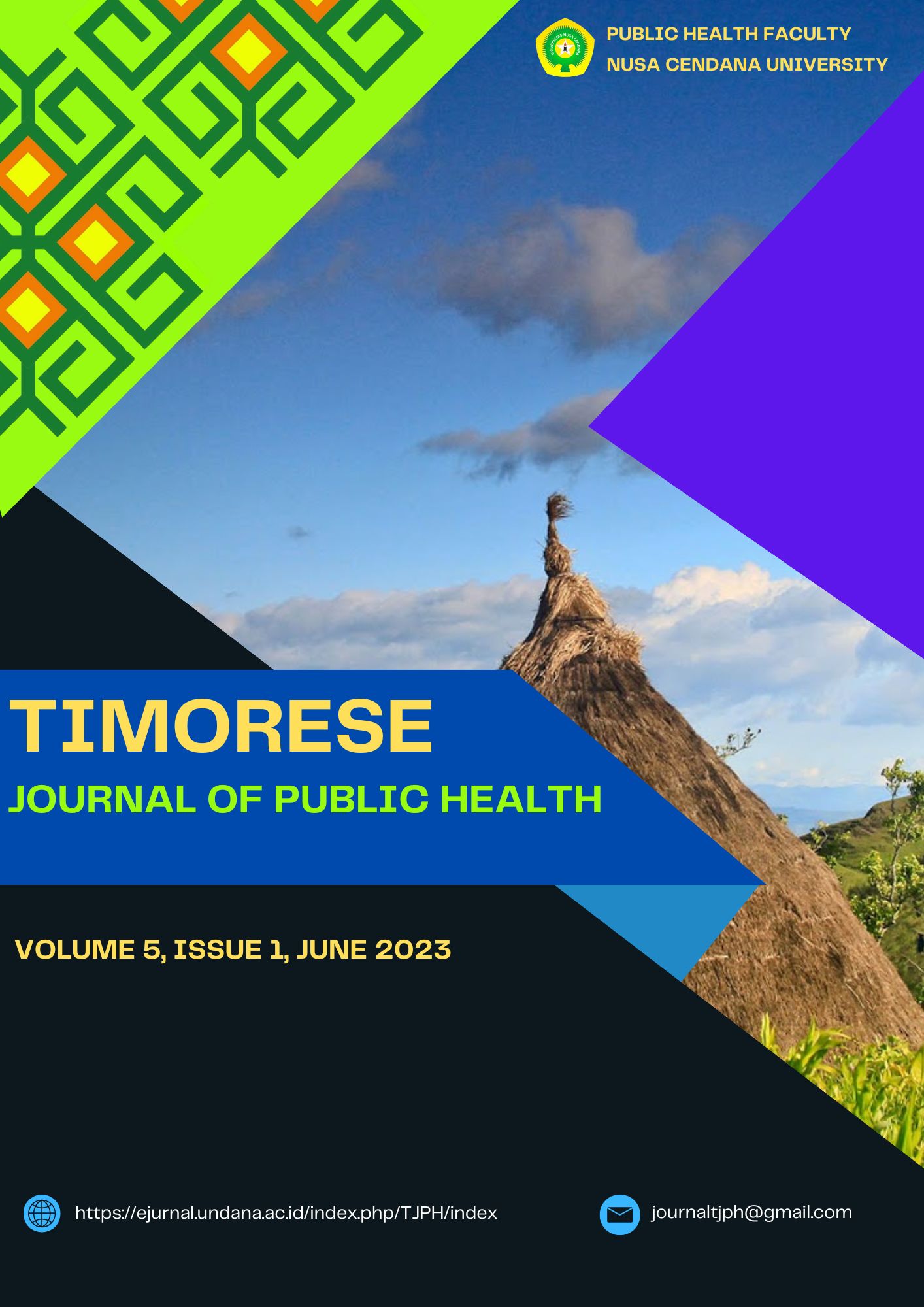Factors Affecting the Occurrence of Stunting in Toddlers in Kalike Primary Health Center, South Solor Distric
Main Article Content
Abstract
Stunting is a long-term problem of malnutrition resulting in children who are too small for their age. Malnutrition occurs when the baby is in the womb and early after the baby is born, but stunting only appears after the baby is 2 years old. Data on stunting cases at the Kalike Health Center are 31.05% in 2020, 20.83% in 2021 and 17% for the August period in 2022. These statistics show that although the number of stunting cases around the Kalike Health Center has decreased, it is still far from the target of 14 percent set in the 2024 National Medium-Term Development Plan (RPJMN). toddlers in the Kalike Health Center area. The research used is a type of analytic observation research with a case control design. The sample in this study amounted to 78 respondents, consisting of 38 case samples and 39 control samples. The data collection instrument in this study used a questionnaire consisting of a questionnaire on maternal knowledge, food intake and parenting patterns. The sampling technique used is simple random sampling with matching. Data analysis used univariate and bivariate analysis with chi-square test. The results showed that the factors influencing stunting included mother's level of knowledge p=0.012 (OR=3.600), energy adequacy p=0.022 (OR=3.294), protein adequacy level p=0.041 (OR=2.875), and history of exclusive breastfeeding. p = 0.036 (OR = 3.035) and parenting style p = 0.038 (OR = 2.970), while factors that did not affect the incidence of stunting were parents' income p = 0.709 (OR = 0.567) and immunization status (p = 0.598). Education about the importance of exclusive breastfeeding must be increased and attention must be paid to a balanced diet, especially energy-sourced foods, to avoid growth retardation in toddlers.
Downloads
Article Details
References
2. Aridiyah dkk. 2016. Faktor yang mempengaruhi stunting pada balita di pedesaan dan perkotaan. e-Jurnal Pustaka Kesehatan, vol. 3 (no. 1) Januari 2015.
3. Arifin, D. Z., Irdasari, S. Y., & Handayana, S. (2012). Analisis Sebaran dan Faktor Risiko Stunting pada Balita di Kabupaten Purwakarta. Diakses dari https://pustaka.unpad.ac.id
4. Cahyono, F., Stefanus, P. M., &Intje Picauly. 2016. Faktor Penentu Stunting Anak Balita pada Bebagai Zona Ekosistem di Kabupaten Kupang. Jurnal Gizi dan Pangan, 2(1), 9-18. https://doi.org/10.25182/jgp.2016.11.1.%25p
5. Corry. O., Arum, C. N., & Maryani, T. (2019). Hubungan Pola Asuh Ibu Dengan Kejadian Stunting Pada Balita Usia 25-59 Bulan Di Wilayah Kerja Puskesmas Sentolo I Kabupaten Kulonprogo Yogyakarta Tahun 2018. Thesis, Poltekkes Kemenkes Yogyakarta. http://eprints.poltekkesjogja.ac.id/id/eprint/2214
6. Dinas Kesehatan Kabupaten Flores Timur. Profil Kesehatan Kabupaten Flores Timur Tahun 2020. Kabupaten Flores Timur; 2020
7. Hamdayani, Sainah, & Mawarni, S. (2021). Hubungan Pola Asuh Ibu Dengan Kejadian stunting pada Anak Usia 12-24 Bulan di Wilayah Kerja Puskesmas Paccellekang Kabupaten Gowo. Patria Artha Journal of Nursing Science, 5, 33-40.http://ejournal.patria-artha.ac.id/index.php/jns
8. Ibrahim, I. A., & Faramita, R. (2015). Hubungan Faktor Sosial Ekonomi Keluarga Dengan Kejadian Stunting Anak Usia 24-59 Bulan Di Wilayah Kerja Puskesmas Barombong Kota Makassar Tahun 2014. Al-Sihah : Public Health Science Journal,7(1),63–75.http://103.55.216.55/index.php/Al-Sihah/article/view/1978Kementrian Kesehatan RI, (2010), Kepmenkes No. 1995/MENKES/SK/XII/2010 Tentang Standar Antopometri Penilaian Status Gizi Anak
9. Kusumawati, dkk. 2015. Model Pengendalian Faktor Risiko Stunting pada Anak Usia 2-3 Tahun (Studi di Kecamatan Semarang Timut). Jurnal Kesehatan Masyarakat Nasional, 9(3):249-256
10. Mugianti, dkk. 2018. Faktor Prnyrbab Anak Stunting Usia 25-60 Bulan di Kecamatan Sekorejo Kota Belitar. Jurnal Ners dan Kebidanan Poltekkes Kemenkes Malang (P-ISSN: 2355-052X). http://jnk.phb.ac.id/index.php/jnk
11. Ni’mah, Khoirun. Nadhiroh, S. R., 2015. Faktor Yang Berhubungan Dengan Kejadian Stunting Pada Balita. Media Gizi Indonesia. 10(1) https://doi.org/10.20473/mgi.v10i1.13-19
12. Pormes, W. E., Sefti R., Amatus Y. I. 2014. Hubungan Pengetahuan Orang Tua tentang Gizi dengan Kejadian Stunting pada Anak Usia 4-5 Tahun di TK Malaekat Pelindung Manado. Jurnal Kesehatan Masyarakat, 2 (2)
13. Rahmatun, Nining Yuliani. 2014. Hubungan Tingkat Pendidikan Ibu dan Riwayat Pemberian ASI Eksklusif dengan Kejadian Stunting pada Balita di Desa Sidowarno Kecamatan Wonosari Kabupaten Klaten. Skripsi. Universitas Muhammadiyah Surakarta. http://eprints.ums.ac.id/eprint/31231
14. Yudianti dan Seani R. H. (2016), Pola Asuh Dengan Kejadian Stunting pada Balita Di Kabupaten Polewali Mandar. Jurnal Kesehatan Manarang, 2(1), 21-25. https://doi.org/10.33490/jkm.v2i1.9.
15. Yusdarif. 2017. Determinan Kejadian Stunting pada Balita Usia 24-59 Bulan di Kecamatan Banggae Kabupaten Majene Tahun 2017. Skripsi. Universitas islam Negeri Alauddin Makasar. http://repositori.uin-alauddin.ac.id/id/eprint/8113

